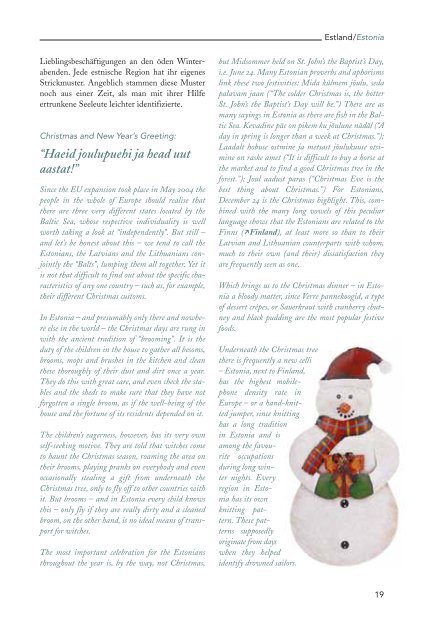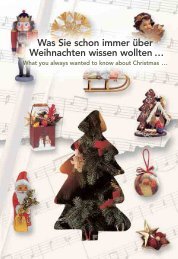Europäische Weihnacht – in Vielfalt geeint - Sutter GmbH & Co. KG
Europäische Weihnacht – in Vielfalt geeint - Sutter GmbH & Co. KG
Europäische Weihnacht – in Vielfalt geeint - Sutter GmbH & Co. KG
Erfolgreiche ePaper selbst erstellen
Machen Sie aus Ihren PDF Publikationen ein blätterbares Flipbook mit unserer einzigartigen Google optimierten e-Paper Software.
Liebl<strong>in</strong>gsbeschäftigungen an den öden W<strong>in</strong>terabenden.<br />
Jede estnische Region hat ihr eigenes<br />
Strickmuster. Angeblich stammen diese Muster<br />
noch aus e<strong>in</strong>er Zeit, als man mit ihrer Hilfe<br />
ertrunkene Seeleute leichter identifizierte.<br />
Christmas and New Year’s Greet<strong>in</strong>g:<br />
“Haeid joulupuehi ja head uut<br />
aastat!”<br />
S<strong>in</strong>ce the EU expansion took place <strong>in</strong> May 2004 the<br />
people <strong>in</strong> the whole of Europe should realise that<br />
there are three very different states located by the<br />
Baltic Sea, whose respective <strong>in</strong>dividuality is well<br />
worth tak<strong>in</strong>g a look at “<strong>in</strong>dependently”. But still <strong>–</strong><br />
and let’s be honest about this <strong>–</strong> we tend to call the<br />
Estonians, the Latvians and the Lithuanians conjo<strong>in</strong>tly<br />
the “Balts”, lump<strong>in</strong>g them all together. Yet it<br />
is not that difficult to f<strong>in</strong>d out about the specific characteristics<br />
of any one country <strong>–</strong> such as, for example,<br />
their different Christmas customs.<br />
In Estonia <strong>–</strong> and presumably only there and nowhere<br />
else <strong>in</strong> the world <strong>–</strong> the Christmas days are rung <strong>in</strong><br />
with the ancient tradition of “broom<strong>in</strong>g”. It is the<br />
duty of the children <strong>in</strong> the house to gather all besoms,<br />
brooms, mops and brushes <strong>in</strong> the kitchen and clean<br />
these thoroughly of their dust and dirt once a year.<br />
They do this with great care, and even check the stables<br />
and the sheds to make sure that they have not<br />
forgotten a s<strong>in</strong>gle broom, as if the well-be<strong>in</strong>g of the<br />
house and the fortune of its residents depended on it.<br />
The children’s eagerness, however, has its very own<br />
self-seek<strong>in</strong>g motive. They are told that witches come<br />
to haunt the Christmas season, roam<strong>in</strong>g the area on<br />
their brooms, play<strong>in</strong>g pranks on everybody and even<br />
occasionally steal<strong>in</strong>g a gift from underneath the<br />
Christmas tree, only to fly off to other countries with<br />
it. But brooms <strong>–</strong> and <strong>in</strong> Estonia every child knows<br />
this <strong>–</strong> only fly if they are really dirty and a cleaned<br />
broom, on the other hand, is no ideal means of transport<br />
for witches.<br />
The most important celebration for the Estonians<br />
throughout the year is, by the way, not Christmas,<br />
but Midsommer held on St. John’s the Baptist’s Day,<br />
i.e. June 24. Many Estonian proverbs and aphorisms<br />
l<strong>in</strong>k these two festivities: Mida külmem jõulu, seda<br />
palavam jaan (“The colder Christmas is, the hotter<br />
St. John’s the Baptist’s Day will be.”) There are as<br />
many say<strong>in</strong>gs <strong>in</strong> Estonia as there are fish <strong>in</strong> the Baltic<br />
Sea. Kevad<strong>in</strong>e päe on pikem ku jõulune nädäl (“A<br />
day <strong>in</strong> spr<strong>in</strong>g is longer than a week at Christmas.”);<br />
Laadalt hobuse ostm<strong>in</strong>e ja metsast jõulukuuse otsim<strong>in</strong>e<br />
on raske amet (“It is difficult to buy a horse at<br />
the market and to f<strong>in</strong>d a good Christmas tree <strong>in</strong> the<br />
forest.”); Joul aadust paras (“Christmas Eve is the<br />
best th<strong>in</strong>g about Christmas.”) For Estonians,<br />
December 24 is the Christmas highlight. This, comb<strong>in</strong>ed<br />
with the many long vowels of this peculiar<br />
language shows that the Estonians are related to the<br />
F<strong>in</strong>ns (jF<strong>in</strong>land), at least more so than to their<br />
Latvian and Lithuanian counterparts with whom,<br />
much to their own (and their) dissatisfaction they<br />
are frequently seen as one.<br />
Which br<strong>in</strong>gs us to the Christmas d<strong>in</strong>ner <strong>–</strong> <strong>in</strong> Estonia<br />
a bloody matter, s<strong>in</strong>ce Verre pannekoogid, a type<br />
of dessert crêpes, or Sauerkraut with cranberry chutney<br />
and black pudd<strong>in</strong>g are the most popular festive<br />
foods.<br />
Underneath the Christmas tree<br />
there is frequently a new celli<br />
<strong>–</strong> Estonia, next to F<strong>in</strong>land,<br />
has the highest mobilephone<br />
density rate <strong>in</strong><br />
Europe <strong>–</strong> or a hand-knitted<br />
jumper, s<strong>in</strong>ce knitt<strong>in</strong>g<br />
has a long tradition<br />
<strong>in</strong> Estonia and is<br />
among the favourite<br />
occupations<br />
dur<strong>in</strong>g long w<strong>in</strong>ter<br />
nights. Every<br />
region <strong>in</strong> Estonia<br />
has its own<br />
knitt<strong>in</strong>g pattern.<br />
These patterns<br />
supposedly<br />
orig<strong>in</strong>ate from days<br />
when they helped<br />
identify drowned sailors.<br />
Estland/Estonia<br />
19



